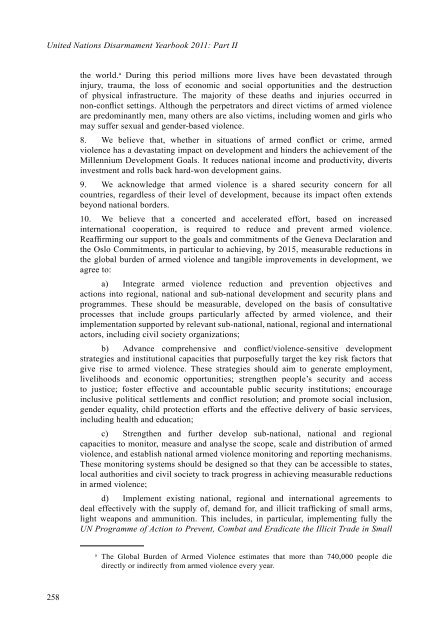DYB2011-Part-II-web
DYB2011-Part-II-web
DYB2011-Part-II-web
Create successful ePaper yourself
Turn your PDF publications into a flip-book with our unique Google optimized e-Paper software.
United Nations Disarmament Yearbook 2011: <strong>Part</strong> <strong>II</strong><br />
258<br />
the world. a During this period millions more lives have been devastated through<br />
injury, trauma, the loss of economic and social opportunities and the destruction<br />
of physical infrastructure. The majority of these deaths and injuries occurred in<br />
non-conflict settings. Although the perpetrators and direct victims of armed violence<br />
are predominantly men, many others are also victims, including women and girls who<br />
may suffer sexual and gender-based violence.<br />
8. We believe that, whether in situations of armed conflict or crime, armed<br />
violence has a devastating impact on development and hinders the achievement of the<br />
Millennium Development Goals. It reduces national income and productivity, diverts<br />
investment and rolls back hard-won development gains.<br />
9. We acknowledge that armed violence is a shared security concern for all<br />
countries, regardless of their level of development, because its impact often extends<br />
beyond national borders.<br />
10. We believe that a concerted and accelerated effort, based on increased<br />
international cooperation, is required to reduce and prevent armed violence.<br />
Reaffirming our support to the goals and commitments of the Geneva Declaration and<br />
the Oslo Commitments, in particular to achieving, by 2015, measurable reductions in<br />
the global burden of armed violence and tangible improvements in development, we<br />
agree to:<br />
a) Integrate armed violence reduction and prevention objectives and<br />
actions into regional, national and sub-national development and security plans and<br />
programmes. These should be measurable, developed on the basis of consultative<br />
processes that include groups particularly affected by armed violence, and their<br />
implementation supported by relevant sub-national, national, regional and international<br />
actors, including civil society organizations;<br />
b) Advance comprehensive and conflict/violence-sensitive development<br />
strategies and institutional capacities that purposefully target the key risk factors that<br />
give rise to armed violence. These strategies should aim to generate employment,<br />
livelihoods and economic opportunities; strengthen people’s security and access<br />
to justice; foster effective and accountable public security institutions; encourage<br />
inclusive political settlements and conflict resolution; and promote social inclusion,<br />
gender equality, child protection efforts and the effective delivery of basic services,<br />
including health and education;<br />
c) Strengthen and further develop sub-national, national and regional<br />
capacities to monitor, measure and analyse the scope, scale and distribution of armed<br />
violence, and establish national armed violence monitoring and reporting mechanisms.<br />
These monitoring systems should be designed so that they can be accessible to states,<br />
local authorities and civil society to track progress in achieving measurable reductions<br />
in armed violence;<br />
d) Implement existing national, regional and international agreements to<br />
deal effectively with the supply of, demand for, and illicit trafficking of small arms,<br />
light weapons and ammunition. This includes, in particular, implementing fully the<br />
UN Programme of Action to Prevent, Combat and Eradicate the Illicit Trade in Small<br />
a The Global Burden of Armed Violence estimates that more than 740,000 people die<br />
directly or indirectly from armed violence every year.


